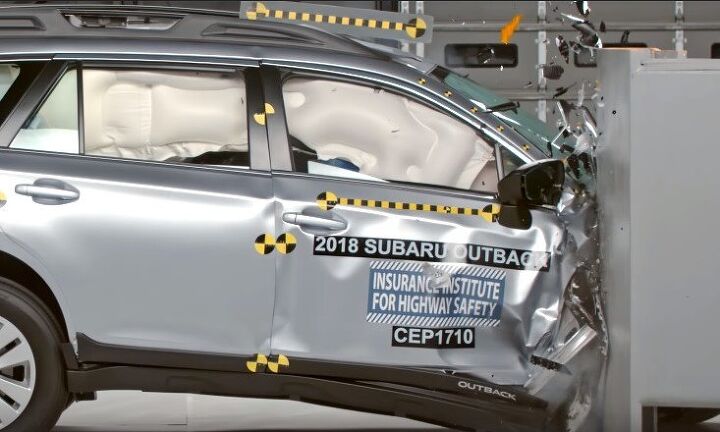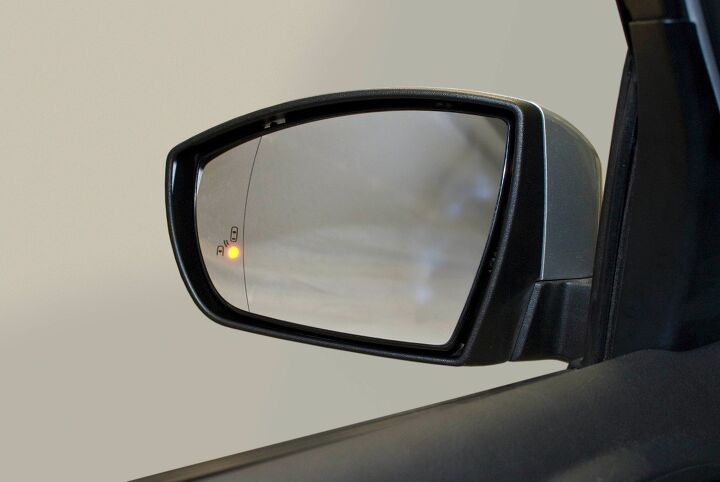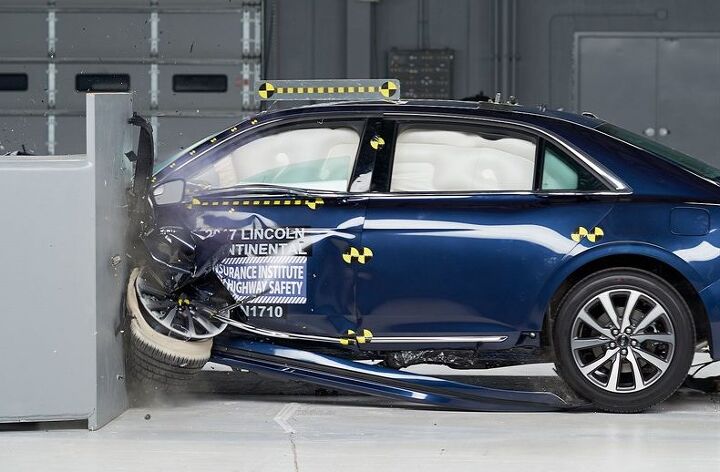#IIHS
Here's Trump's Ace in the Hole for Dialing Back MPG Rules
It’s no secret that the Trump administration will eventually come forward with a relaxed version of existing automotive fuel economy targets. Despite previously agreeing to them, most automakers have decided Obama-era goals are less than ideal and have reached out to the current president to take it easy on them — something he appears willing to do.
However, the White House is going to have to sell the decrease to numerous states that claim they won’t accept such a proposal, as well as a driving public that likely doesn’t want to spend more money on fuel than it has to. Fortunately, the administration has a strategy for this, and has tapped the National Highway Traffic Safety Administration for backup. It’s trying to prove that cutting fuel economy would actually make vehicles safer.
2018 Pickup Crash Ratings Show What the New Crop of Trucks Needs to Get Right
Truly, this is a momentous year for trucks. Not one, not two, but three completely revamped or wholly new domestic pickups greeted us in Detroit last week, ready to capitalize on America’s unyielding hunger for vehicles that can haul, tow, ford, climb, traverse, and commute daily with a single occupant.
While we haven’t yet had an opportunity to put the 2019 Ram 1500, Chevrolet Silverado 1500, or Ford Ranger through their paces, we’d hope to find an increase in refinement and capability in returning models. Over at the Insurance Institute for Highway Safety, however, there’s a different testing regimen planned. Let’s just say it’s a hard-hitting one.
And if Ram or Chevy wants to get into the IIHS’ good books, those trucks had best perform better than their so-so predecessors.
The IIHS is Hoping For a Bright Future When It Comes to Headlights
Even though headlights have evolved from uniform circles illuminating the roadway in largely the same way to diverse units that look and function very differently, their overall performance has improved immensely. Nobody is going to jump from a 1955 DeSoto to a 2018 Dodge and think “Wow, these headlamps are just terrible.”
However, the International Institute for Highway Safety has been on a two-year mission to make modern headlights look bad and there are two possible explanations as to why. Either the IIHS genuinely believes the current offerings from manufacturers are unsafe, or it’s trying to promote competition within the industry to produce a better bulb. The truth, as usual, is likely somewhere in the middle.
The IIHS' Updated Criteria Absolutely Devastated Its Top Safety Pick List
While the Insurance Institute for Highway Safety has steadily upgraded its standards over the last two years, the effort hasn’t been without casualties. In a new effort to improve headlight safety and impact protection, the organization has changed its testing criteria for 2018 to include both illumination and passenger-side frontal impacts.
Unfortunately, including these aspects in its final verdict of how safe a vehicle is has removed numerous models from consideration for 2018’s Top Safety Pick+ awards. Last year, 38 vehicles qualified for the safety plus appointment. This year, however, the grand total only came to 15 models — most wearing badges from Hyundai Motor Group and Subaru.
The IIHS makes no apologies for keeping so many cars from receiving top honors. Instead, it claims it was time to heap higher expectations on automakers for items like visibility and passenger safety.
Which Segments Incur the Largest (or Smallest) Insurance Losses?
Insurance may be one of the greatest scams ever pulled on the general public, but it’s a very necessary evil. Right around the time the automobile became popular, people starting crashing them into things. By the 1920s, individual states began requiring drivers to purchase insurance — creating a pooled solution that covered at-fault drivers for damages they might be unable to pay otherwise.
However, not all drivers crash and not all vehicles incur the same costs when they take or deliver a beating. Collision losses might be astronomical for high-end sports cars but comparably moderate for midsize pickup trucks. The Insurance Institute for Highway Safety and Highway Loss Data Institute recently compiled the loss averages for hundreds of models, grouping them by segments, to establish how lightly-used autos stack up against each other.
IIHS Throws Another Hurdle at Automakers: The Passenger-side Small Overlap Crash Test
First, the Insurance Institute for Highway Safety bagan irking the automotive industry by performing crash tests. Then it devised more. Eventually, the IIHS ratcheted the bar up to a previously unseen height, demanding vehicles undergo the dreaded small overlap front crash test — a 2012 addition to its testing regimen. Covering just 25 percent of the frontal area of the car, the test mimics a not-quite-glancing-enough head-on collision, or perhaps an impact with a tree or utility pole.
New vehicles failed the test in droves. Firewalls were deformed. Dummies’ legs exited the vehicles in mangled fashion. The Dodge Challenger got a black eye. In response, the industry raced to beef up its front ends, eager for a marketable high crash test score.
Now, a year after becoming concerned that automakers were focusing efforts on only the driver’s side of the vehicle, IIHS is turning its attention to the passenger side. A new crash test is born. But how did the first crop of vehicles — 13 midsize cars — fare in this new test?
Piston Slap: Is Your Squib Still a Tower of Power?
Smaller Pickups Outperformed the Big Boys in IIHS Overlap Crash Test
The Insurance Institute for Highway Safety recently ran eight pickups through the small overlap front crash test, which replicates one of the most infamous and deadly of accident types — one where the front corner of a vehicle collides with another vehicle or object. The segment, which the IIHS called “small pickups,” could easily be categorized as midsize. But, with no smaller options currently available in the domestic market, their terminology works well enough.
So, how did the smaller pickups stack up when hurled toward a concrete pylon at 40 miles an hour? A little better than you might expect.
If we were absolutely forced to drive into a brick wall, we’d probably prefer to be seated in a full-size truck — specifically the Ford F-150 SuperCab. But the junior pickup group wasn’t a segment full of deathtraps. In fact, they suffered less structural deformation overall and posed less risk of injury to the lower leg region when compared to their full-size brethren. There were exceptions, however.
Lane Departure Warnings, Blind Spot Alerts (Probably) Reducing Crashes: Study
Lane departure alerts and blind spot monitoring systems can significantly reduce crashes if consumers use the features, according to two recent studies by the Insurance Institute for Highway Safety. While this information falls into the no-brainer category, rarely do we get specific metrics on these particular technologies.
“This is the first evidence that lane departure warning is working to prevent crashes of passenger vehicles on U.S. roads,” explained Jessica Cicchino, IIHS vice president for research. “Given the large number of fatal crashes that involve unintentional lane departures, technology aimed at preventing them has the potential to save a lot of lives.”
These Large Cars Offer the Most Luxurious Crash Experience
Like the rest of North America’s passenger car market, full-size sedan sales are waning. While luxury vehicles haven’t taken quite the same hit as more affordable models, big cars are not in fashion for 2017. However, some buyers still prefer the distinction and mass that only a full-size automobile can provide. They want a luxurious, low-slung ride and, if possible, an equally elegant crash experience.
While big cars tend to perform better in accidents than the majority of their petite contemporaries, very few vehicles do well in the small overlap crash test. The Insurance Institute for Highway Safety recently took six of its favorite picks from the segment to evaluate side impact crashes, roof strength, protection from head restraints, moderate overlap front crashes, and the dreaded small overlap front impact.
“This group of large cars includes some with stellar ratings, but our small overlap front test remains a hurdle for some vehicles,” explained David Zuby, IIHS executive vice president and chief research officer.
Study Links Legalized Recreational Marijuana to Increased Crash Rates
Tragically, the Insurance Institute for Highway Safety has correlated the legalization of recreational marijuana use with more automobile accidents. Pot smoking in Colorado, Oregon and Washington seems to have resulted in collision frequencies roughly 3 percent higher than what would have been expected without legalization, according to a recent analysis from the Highway Loss Data Institute.
While this certainly isn’t an endorsement for de-legalizing recreational marijuana use, it is a reminder to stay off the roads if you’re having your head changed. Operating a motor vehicle while baked can get you into a sticky-icky situation, and nobody wants you having a green out on the expressway. That said, risks associated with driving under the influence of marijuana are much less cut-and-dried than alcohol.
This is largely due to how difficult it is for researchers to test marijuana. Despite its growing legalization, marijuana is classified by the Drug Enforcement Agency as a Schedule 1 drug, and subject to the highest level of restriction. Researchers need approval from their institution and apply for a license from the DEA before conducting a study. The government also has only so much pot to dole out for research purposes and gives the majority of it to the National Institute on Drug Abuse — fair and balanced testing of whether or not getting high while driving is safe is a little lower on NIDA’s list of priorities. In this instance, the same might be suggested of the IIHS.
Piston Slap: The Life Cycle of Structural Enhancements
Chris writes:
Hi Sajeev,
I’m in the market for a new(er) car to replace my 2005 Nissan Quest. Safety is a very important precondition for my purchase since it will be used to transport my kids around our very congested city. I was thinking about leasing a 2017 model and narrowed my search down to a Chevy Equinox, Nissan Rogue, or Mitsubishi Outlander (all about $200/month for 36 months with $3K down). In crunching the numbers, I quickly realized that with the $10,200 or so that I’d spend on leasing a car that I’d eventually have to part ways with, I could easily buy a low mileage example that was between 3-6 years old.
IIHS: Half of All Midsize SUV Headlights Rated Marginal to Poor, Blind Everyone
The Insurance Institute for Highway Safety has been systematically tearing apart every segment over inadequate headlights for the past year. In its most recent study, midsize SUVs took a beating, with only two models garnering a “good” rating for their illumination capabilities. The other 35 continued a trend of providing lackluster performance from a safety standpoint — especially non-luxury offerings.
Lousy headlights are something the IIHS seems hellbent on calling out, especially after years of avoiding any heavy scrutiny. This is the fourth segment the institute has evaluated since it began rating headlights in 2016. Its newly established headlight ratings have resulted in fewer cars being awarded an IIHS Top Safety Pick+, as headlights must rate in the “good” or “acceptable” range to even be considered.
When Will Automatic Braking Become Standard Equipment?
There was a time when seat belts were considered unnecessary, reserved as an optional extra for motorists who ventured out onto roadways in a state of white-knuckle fear. What pathetic bags of flesh, many thought, wrapping themselves in a polyester harness because they can’t handle themselves on the road — thinking it will save them from the reckoning of sheet metal and glass.
We know better now. Seat belts are proven life savers and advanced restraint systems are compulsory for both automakers and occupants. That will likely be the path of automatic emergency braking takes as well. Nissan announced Thursday it would make auto braking systems standard on a large portion of 2018 models sold in the United States. Toyota is doing the same. But the technology is not yet ubiquitous, nor has it acquired universal public approval. Many worry it could be too invasive or provide a false sense of invincibility, so it could be a while before AEB becomes expected equipment on all new models.
These Vehicles Offer the Highest Rates of Driver Death
After a notable decline in driver fatalities during the Great Recession, deaths are back on the rise. However, the increase is rather minuscule compared to every other decade since automobiles became North America’s preferred mode of transportation and the number is projected to go back down in the years to come.
The averaged rate of driver deaths for 2014 models was 30 fatalities per million registered vehicle years, up from the 2011 low of 28. Fatal crashes rose a further 7 percent in 2015. This is can primarily be attributed to people having more reasons to drive when the economy is better, and those added miles translate into additional opportunities for crashes.
More interestingly, however, is which vehicles drivers are losing their lives in most often. As expected, smaller vehicles often are the most dangerous to occupy in the event of an accident but the stats between individual models vary widely.






























Recent Comments